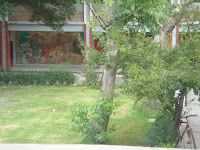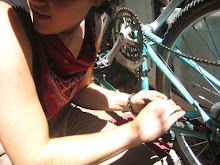Silly picture of me, compliments of my classmate Mateo:

1. Teotihuacan: A PreClassical Mexican Ghost Town,
or, What´s In Store For Us
7. Museo del Estanquillo
2. De Don De Son,
or, La Copia Pirata de Lo Autentico, PLUS discussion of *authenticity* as a topic
3. Ciclotón!,
or, Lost in The Damn City
4 Gajillion. An Ode to Street Tacos
1. Two Sundays Ago! We went to Teotihuacan, all of us Californians, crawling around the once-time cultural hub of North America*. This was the place to be, man. If you weren't here, you were decidedly square. Here, my friends, is the story: we aren't totally sure where they came from, but they showed up on the north side of the lake system, set up shop, and eventually started building pyramids for the gods, as if to say: thanks for the hills, guys, that was really nice of you. We like them. We will make you some hills in return. No, I mean it. That was the idea. It was a reciprocity with the gods. Kind of like

taking your friends out to coffee: you just do sometimes. But what wound up happening, and how the pyramids got so big was that every generation of rulers would be like, man, this pyramid just isn't big enough. (Can I mention that I figured out how to make apostrophes again? I'm stoked about apostrophes.) So they would build another pyramid on the outside of an existing pyramid. Because they were shrewd. And so their empire became the Mexico City of ancient Mexico, but they kind of outgrew their britches, overhunted, deforested, hogged all the commerce, and by 750 BC those suckers went DOWN. So when the Mexica (the proper name for the Aztecs: they were called the Mexica [pron. meh-SHEE-kah] but they always said they were from someplace called Aztlán [nobody is really sure where that is, but they think it's in the North someplace) arrived, all they found were vaguely pyramid-shaped piles of rocks: an eerie, oversized ghost town. And this city had it all: beautifully stuccoed, polished and painted buildings, a sewage system, city planning with a religious basis, bla bla bla. I'm pretty sure it gave the Mexica the heebie jeebies, but it was all for the best I guess because they went on to find their Eagle/nopal/snake experience and live happily for a while after. That was in the 1300s, so by then the joint was pretty broken down. BUT here's the deal: eventually a bunch

of archaeologists found Teotihuacan, and like archaeologists, decided to break rocks and dig holes and generally poke history, and discovered that under these vaguely pyramid-shaped piles of rocks, there were...
distinctly pyramid shaped piles of rocks, stucco, polish and paint intact because they had been protected all these years by the bigger-better pyramids that took all the flak from nature since the 700s. So, when you go to Teotihuacan, you go inside the pyramids (which in their heyday were not go-insideable, thank you archaologists). Basically they were totally badass engineers, but bad long-term planners.
Kind of like us.

Whatever, afterward we went to go eat fancy dinner
in a CAVE!! I ate the most delicious chicken mole in the world while marveling at the beautiful irony of a fancy cave.
2. For a school project, I went to the Museo del Estanquillo downtown with two other UC kids. The exhibit was called "Te Pareces Tanto a Mí", or, "You Look So Much Like Me". It dealt with portraits throughout Mexican History. I was looking at the Benito Juarez section, and there were these two English kids with very posh accents: "I suppose this fellow was quite important." No shit, homes. So I history-nerded them. "Um, yeah, he was kind of a big deal. First elected president of Mexico. Helped oust a dictator. Wrote the constitution, Booted the Catholic Church, was indigenous+in power which prior to that was unheard of. Got replaced with an Austrian monarch. Poor guy had no idea what was going on--his name was Maximilian, and really he was nice enough, he had just been duped by a gang of rich conservatives who for god knows what reason really wanted a king so they wrote his father a nice letter and said, O King Guy, send somebody to be our Absolute Monarch, that we may too be subjected to the unfettered power of someone so wealthy and ignorant as thee! So they shipped Max over and he lived in the Castillo de Chapultepec, and did some actually okay things, but then the Liberals showed up and Benito Juarez said, okay, look, I'm really sorry, but we're going to have to execute you now. That's just how it works when you stage a coup. Gotta set an example, you know. So that's how Max got offed. Anyway, Juarez then proceeded to be president for a very short while before he suddenly died, which on some level, was probably okay, because he died before he could start to look like a jerk, which is what any politician will eventually do, and this is a country that needed a national hero worse than any other concept. So that's Benito Juarez." And they looked at me, eyes as wide as dinner plates, and said, gee, thanks...

But the point of this story is more about the exhibit itself. It brings to light questions about the manufacture and distribution of IMAGES. Okay, here we are in a blog, the land of image-mongering, wherein we create and destroy ourselves and others at will. But think of it, mass publishing of images is a relatively new thing. How do you communicate to somebody in California that they have this guy in Washington DC telling them how to behave? I mean, it's mind boggling! And humans used to live in an image-bottleneck: few images, and few avenues for their distribution. It's a miracle that people even believed that government existed. No wonder there were a bunch of militias and other such wackos back then. So I'm not going to dawdle on this much longer, but I'm going to render for your digestion the discussion questions I generated for the presentation I co-led today on this exhibit:
1. Images and power: Who controls the creation and distribution of images? How do these images have power over us? What qualities of an image determine the answers to these questions (medium, distribution channel, creator, subject....)?
2. How do people in power use their own image? How is this image manipulated and used by others? What effect does this have on their power?
3. How do artists portray themselves and other artists? Why do we even care?

4. "Los demás": how can images serve to demarginalize or further marginalize people who have no power? What does this mean for our perception of them? What power have we to change this--how do images help give us this power?
NEXT!
DE DON DE SON
I may have mentioned to some of you the seemingly sketchball friendship I struck up in the metro: leaving Jafet's place for my new abode I was fraught about by my suitcase, backpack and uke: a piece I like to call one overloaded chick descending staircase, Metro Zócalo... when... a kid stops me and says, hey, what's that instrument? I show it to him, and he breaks out his jarana, and we talk about the tuning and where they're from... we exchange phone numbers and agree to jam. Only later did it occur to me that I am in no way ready for jamming of any sort. Jeez. We wound up meeting up for coffee one afternoon, and he taught me a little jarana technique, and then last Friday, we met at the Metro, this time I brought the Uke Machine, and walked to his friend's place, and I basically got to sit in on his band practice, which was AMAZING! His band is called De Don De Son (a play on words I will explain momentarily) and the music they play is called Son Jarocho. The story is that he and one of the other guys knew each other sort of kind of

in their early days because they were both in punk bands around town. Then, simultaneously and without any communication on the topic, they both got into Son Jarocho, and that´s how they started playing together. Okay, one foot in front of the other. What is Son Jarocho? It´s a traditional kind of music from the state of Veracuz, right on the east coast of the Gulf of Mexico, and so it has sustained plenty of Spanish influence, as well as Carribbean influence. In its percussion and rhythm it reminds me a lot of Cuban music. The vocals, too, actually. Maybe you can find an example on the Internets, such as http://www.youtube.com/watch?v=C1VkMDWEjpU&feature=PlayList&p=CFDB9705486EDECC&playnext=1&playnext_from=PL&index=1 . Furthermore, the instruments are really beautiful. The jarana comes in several sizes, two of which were present here: the mosquito (slightly littler than a uke) and one slightly smaller than a guitar. They are organized in theory the same way as a uke: GCEA, but here's where it gets funny: each string is paired: so C, E and A come in duplicate to get a more sproingy sound, and so does the G but the G pair is split, top and bottom, I guess so you can't miss the string to ensure complete chords even when playing drunken-sloppily. Another string instrument is called the requinto, which looks in this case like a 5-string guitar whose strings you whack with a piece of bull horn which is shaped not like a pick, but a small paddle. Clearly it´s a very string-heavy ensemble, and everyone seems to play more or less every instrument (except for the tambourine guy, who seems to just play the tambourine-- but that´s not to knock tambourine guy, because I have never heard such tambourine-complexity in my entire life!). They were all really serious about the music, but they were clearly having the time of their lives. The songs are so beautiful; the verses get sung in turns, and the lyrics usually deal with very quotidian things, like food, love gone wrong, the countryside. So basically I went to a free concert. Ah, the name. They were playing once in a bar or in the metro or some such and they finished a song and somebody asked them, --De donde son?-- or, where are you from, so caught up in the contradiction that they sounded straight out of the boondocks of Veracruz but looked like Chilangos (Mexico City kids: t-shirts, skate shoes, cargo pants, weird hairdos...). Their band name is De Don (don means you´ve got a mastery of something) de Son (Son Jarocho). Last night they were joking about how they are an authentic pirated copy of Son Jarocho.
Which brings me to the question of authenticity: when you travel abroad, you find yourself seeking the holy grail of AUTHENTICITY. "Was it made by hand? Make it spicier, I can handle it! Is she indigenous or does she just dress like that?" People get these crazy blinders on. I guess there's a paranoia about getting duped, caught in a tourist trap, looking like a dumb foreigner. Well, guess what, I'm a dumb foreigner, and I think I've got to own up to it. I look around and I try to not normalize, necessarily, but think actively about how people behave, what they do to their appearances, what they eat, what they do all day, what their world looks like, smells like... I'm not here to buy The Real Mexico. You know what? I bet you fifteen pesos that there is no The Real Mexico, and that authentic is as relative as Who I Am. Cultural identity is fluid, and any attempt to put it in a box is going leave you cold.
NEXT!
Ciclotón! Sunday morning I woke up earrrrly so I could jump out of bed, onto my bike and go help Erika and Daniel fix bikes at the Ciclotón, which they've done a few times now and it's probably helping out their business to get this exposure to recreational cyclists. I figured out where to go on the map and got rolling. Down calle Mexico-Coyoacan (stopping at a spot called El Jarocho for coffee, which I brought with me in my sweet cylindrical belt-clipping thermos, thank you Margareta and Jaylee!!) to Avenida Rio Churubusco, where the roads were supposedly closed for cyclists. Gee, that's weird. A ton of cars, and no cyclists... Pass the Leon Trotsky museum... realize that Rio Churubusco is actually a big giant highway and that this is the Rio Churubusco Periferico... aha! Clumsily dash across street, climb over short fence with bicycle, y ya! But, of course, I went the wrong way, and called Erika from Patriotismo, to say, well... um... I'm on the opposite side of city? So with her instructions in mind, I bought a mole tamale, sucked down a little coffee, and took off, straying from the Ciclotón track, and rolling down Eje 4 alllllllltheway across the city. I got back to the track, made a wrong turn and in so doing had to fight the flow of traffic 5 kilometers, backtracked, and found the Planeta Cleta tent. They fed me, and I helped them out pumping tires and calibrating derailers for about an hour before I had to split. Boy was I tired. 4 hours lost on a bike in DF? Yikes. Here are some funny things I saw:
1. FIXIE KIDS!!! Just 2 of 'em. I don't know whether they were gabachos out for a jaunt or what, but they looked like somebody had transplanted them from Davis (more like Davis fixie kids than SF fixters).
2. Puppies in baskets.
3. A beaver-cleaver heterosexual nuclear family, Ma/Pa/2 kids/1 baby in trailer:
all wearing the same orange and white striped polo shirts. It was the funniest thing. I laughed.
Not related, but cool: in Veracruz they do this religious dance in honor of the Precession of the Equinoxes (I pulled that term from a children's story), or the spinningness of the world, and they start of on top of a giant snag, where they are all sitting on a lazy susan, and one winds it up and then the other four go careening off as they spin around the tree. It's amazing...

Lastly, An Ode to Street Tacos:
Born of a giant basket on an old man's bike
How you are tasty.

 and try. They consist of cornbread, effectively, but steamed, with a filling like rajas (chopped chile in tomato sauce), verde (tomatillo salsa), mole (which is the best sauce ever and has like a million varieties each with a million ingredients) or dulce, which is just where they sweeten the cornbread and dye it pink. They come wrapped in corn leaves, because that's how they hold their shape when they steam them, in these little corn-leaf envelopes. Atole they tend to serve either out of one of those old-school steel milk tanks or out of a giant cylindrical orange Gatorade cooler. Either way it's this delicious drink made from water, milk and corn starch (which dissolves better than you'd think), usually flavored with chocolate, fruit, or rice (with bits of rice in it, it tastes like rice-pudding). If you want to feel full in the morning you have a tamale and an atole and you're good to go. You don't even want to think about eating after that.
and try. They consist of cornbread, effectively, but steamed, with a filling like rajas (chopped chile in tomato sauce), verde (tomatillo salsa), mole (which is the best sauce ever and has like a million varieties each with a million ingredients) or dulce, which is just where they sweeten the cornbread and dye it pink. They come wrapped in corn leaves, because that's how they hold their shape when they steam them, in these little corn-leaf envelopes. Atole they tend to serve either out of one of those old-school steel milk tanks or out of a giant cylindrical orange Gatorade cooler. Either way it's this delicious drink made from water, milk and corn starch (which dissolves better than you'd think), usually flavored with chocolate, fruit, or rice (with bits of rice in it, it tastes like rice-pudding). If you want to feel full in the morning you have a tamale and an atole and you're good to go. You don't even want to think about eating after that. flavor for popsicles. I bet they have guanábana popsicles in the Mission. There's a lovely Son Jarocho song about a guanábana.
flavor for popsicles. I bet they have guanábana popsicles in the Mission. There's a lovely Son Jarocho song about a guanábana.







































